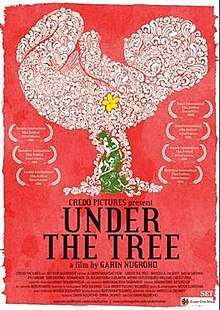Under the Tree (2008 film)
Under the Tree (Indonesian: Di Bawah Pohon) is a 2008 Indonesian movie directed by Garin Nugroho, as a follow-up to his celebrated film Opera Jawa. The movie stars Marcella Zailanty, Nadia Saphira, and Ayu Laksmi as the three women in their respective stories in the movie.
| Under the Tree | |
|---|---|
 | |
| Directed by | Garin Nugroho |
| Written by | Eros Djarot |
| Starring | Marcella Zalianty Ayu Laksmi Nadia Saphira |
| Cinematography | Yadi Sugandi |
| Edited by | Andi Pulung Waluyo |
Release date | 2008 |
Running time | 104 minutes |
| Country | Indonesia |
| Language | Indonesian |
Similar to Opera Jawa, Under the Tree was universally praised by reviewers from both Indonesian and foreign countries' critics, with praise mostly directed to Nugroho's artistic view on the subject and the cast's performance. After released in several foreign countries, Under the Tree was released in Indonesia and was acclaimed, ended up receiving seven Citra Award nominations, including for Best Picture, Best Director for Nugroho, and Best Actress for Laksmi, winning two awards; Best Supporting Actress for Aryani Kriegenburg Williems and Best Art Direction.
Plot
The film follows three women on their individual journeys in Bali. The first, Maharani (Marcella Zalianty), is an adoptee from Jakarta who has come to Bali to look for her birth mother. The second, Nian (Nadia Saphira), is a celebrity who goes to Bali to escape her family life back in Jakarta. The last, Dewi (Ayu Laksmi), is a radio personality whose husband is never home and who is carrying a dead child in her womb; Dewi must eventually choose whether to live or to commit suicide.
Production
Nugroho and his production team spent 20 days filming on Bali, including in Ubud, Sanur, and Karangasem.[1] The film was produced without a screenplay. Instead, the actors were asked to discuss their ideas for their characters with Nugroho, to ensure that they understood their own character.[2]
Themes
Nugroho notes that Under the Tree is a critique of suicide in Indonesia, and how very few people pay attention to it, including the government. He notes that "trees are attached to human lives".[3] Nugroho has also stated that the movie has an environmental message.[1]
Release and reception
Under the Tree had its world premiere at the BFI London Film Festival.[4] It later competed in the Tokyo Film Festival.[3]
Nauval Yazid of The Jakarta Post notes that Under the Tree is somewhat mainstream for Nugroho, who generally makes art films. The film's choreography during the Balinese dancing is praised, as is storyline and Laksmi's performance. However, the other two main characters are described as not resonating as much as Laskmi, and the use of the shaky camera technique is criticized.[5]
In its review of the film for the Toronto International Film Festival, Variety notes that Under the Tree mixes traditional Balinese music with modern issues, similar to the Javanese music used in Nugroho's previous film Opera Jawa; the execution is noted to be not "as well integrated" as in the older film. The brown-tinted and shaky camerawork was considered "sometimes near-nauseating."[6]
References
- Footnotes
- Bibliography
- "Garin Soroti Krisis Lingkungan di 'UNDER THE TREE'" [Garin Discusses the Environmental Crisis in 'UNDER THE TREE'] (in Indonesian). KapanLagi.com. Retrieved 30 September 2011.
- "Garin's film to premier at London Film Festival". Jakarta Post. 11 September 2008. Retrieved 30 September 2011.
- "Suicide cases inspire Garin". Jakarta Post. 23 October 2008. Retrieved 30 September 2011.
- "Under the Tree". Variety. 11 September 2008. Retrieved 30 September 2011.
- "Wajah Beda Indonesia dalam Under The Tree" [Indonesia's Different Face in Under the Tree] (in Indonesian). 21 Cineplex. Retrieved 30 September 2011.
- Yazid, Nauval (11 January 2009). "Some magic remains buried 'Under the Tree'". Jakarta Post. Retrieved 30 September 2011.